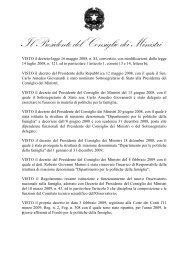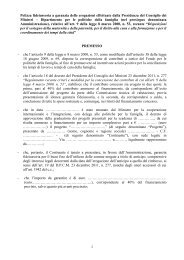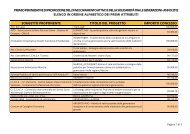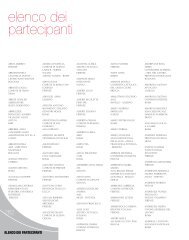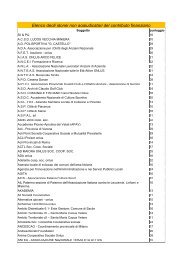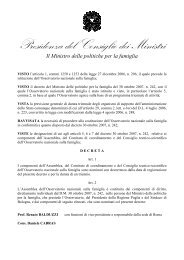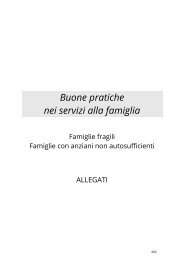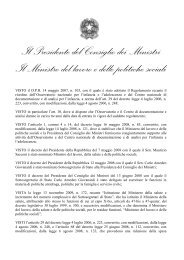The extra-ordinary Plan 2007-2009
The extra-ordinary Plan 2007-2009
The extra-ordinary Plan 2007-2009
Create successful ePaper yourself
Turn your PDF publications into a flip-book with our unique Google optimized e-Paper software.
Expert Conference Accompanying the Informal Meeting<br />
of Ministers for Family and Gender Equality:<br />
"Mechanisms for reconciling professional and family<br />
roles for women and men as a chance to actively<br />
participate in the labour market"<br />
Cracow 20-21 October 2011<br />
This conference is supported by the European Union Programme for Employment and Social Solidarity – PROGRESS (<strong>2007</strong>-2013)
"Mechanisms for reconciling professional and family roles for women and men<br />
as a chance to actively participate in the labour market "<br />
Increasing the childcare supply: the Italian example<br />
Roberta Ceccaroni, Senior Adviser, Department for Family Policy, Italy
<strong>The</strong> Institutional Context in Italy<br />
<strong>The</strong> Department for Family Policies<br />
From 2006, a Department for Family Policies (DFP) of the Presidency of Council of<br />
Ministers was established. At present, a Secretary of State, member of the<br />
Government, Senator Carlo Giovanardi, is responsible for the Department.<br />
A special plan has been launched from <strong>2007</strong>,<br />
Extra-<strong>ordinary</strong> three-year plan <strong>2007</strong> <strong>2009</strong>,<br />
through an agreement between central and local authorities<br />
(Intesa in Conferenza Unificata – Government Regions and autonomous areas)
<strong>The</strong> Institutional Context in Italy<br />
<strong>The</strong> new constitutional rules identify three sectors of legislative power:<br />
a) exclusive State legislative power<br />
b) combined legislation (State and Regions share the competence)<br />
c) residual legislative power<br />
<strong>The</strong> State identifies the essential levels of social services and benefits concerning civil<br />
and social rights that should be guaranteed in the entire national territory, the<br />
fundamental principles and the general norms<br />
Everything else is under the Regions’ competence<br />
<strong>The</strong> Local Government manages the administrative activities
<strong>The</strong> Italian Context<br />
• Fertility rate: 1,41 Italy 2,23 OCSE (<strong>2009</strong>)<br />
– In 1963: 978.110 newborns, in 2010: 561.944 newborns<br />
one out of every three women born in the baby boom years has no children<br />
• Female employment rates (15-64) - Eurostat <strong>2009</strong>:<br />
– Italy 46,4%<br />
– UE27 58,6 %<br />
After the birth of a child 25% of mothers resident in the South of<br />
Italy and 15% of the residents in the North of Italy stop working (“To<br />
be a mother” - ISTAT 2005)
Cross-country relation between female employment rates and total fertility rates<br />
1980 <strong>2009</strong><br />
Sources: Employment rates - OECD Employment Outlook UN World Statistics Pocketbook, 2010; Fertility rates -<br />
National statistical authorities, UN Statistical Division and Eurostat Demographic Statistics, 2010..
Relationship between the female employment rate in <strong>2009</strong> and the<br />
change in the fertility rate in the period 1997-<strong>2009</strong> (Del Boca and Rosina,<br />
<strong>2009</strong>)
<strong>The</strong> female employment rates decrease strongly with the increasing of<br />
the number of children:<br />
From 0 to 1 child value drops by 5 points, from 0 to 2 children by 10 points and<br />
from 03 children by 25 points<br />
Female employment rate by number of children (under 15 years) OCSE
Female employment rate by age of youngest child<br />
(OECD 2006)
Childcare services<br />
<strong>The</strong> evolution trend during the last 40 years<br />
• Firts legislative experience: law n.1044 of 6 december 1971<br />
• Before: health care and assistance services <strong>The</strong>n: social services and<br />
assistance, Now: an educational and welfare vocation (educational aim)<br />
• A better articulation of the supply system, has been realized by making<br />
the nido d’infanzia (the most important and consolidated typology of<br />
education service) more flexible and by developing other integrative<br />
services (in particular, the play-areas, the centers for children and parents<br />
and home-based education and care facilities):<br />
– integrated educational services<br />
• A progressive differentiation among the main actors involved in the<br />
creation and management of these facilities, with a growing presence of<br />
non profit private subjects:<br />
public-private integrated system of services
Childcare services<br />
Territorial range (Istat 2004)<br />
• <strong>The</strong> general dynamics of the system during the last years not only do not mitigate the<br />
differences between territories but, on the contrary, tend to foster them<br />
• Low supply at national level, with an average coverage of 11.4%, and a strong territorial<br />
inhomogeneity coverage with average values equal to 4% in the South<br />
% di bambini accolti<br />
(numero di regioni nell'intervallo)<br />
• Children who use the early<br />
childhood services by geographical<br />
area (out of 100 children aged<br />
between 0 and 2 years):<br />
19,4 a 24 (2)<br />
14,8 a 19,4 (1)<br />
10,2 a 14,8 (7)<br />
5,6 a 10,2 (2)<br />
1 a 5,6 (8)<br />
11,4% Italy<br />
27,5% Emilia Romagna<br />
1,7% Campania<br />
(Year 2004 - National Institute of Statistics<br />
ISTAT )
<strong>The</strong> <strong>extra</strong>-<strong>ordinary</strong> <strong>Plan</strong> <strong>2007</strong>-<strong>2009</strong><br />
Aims and Tools<br />
Incrementing socio-educational services for early childhood by launching a<br />
special plan, an <strong>extra</strong>-<strong>ordinary</strong> three-year plan <strong>2007</strong>-<strong>2009</strong>, through an<br />
agreement between central and local authorities (Intesa in Conferenza<br />
Unificata – Government Regions and autonomous areas)<br />
<strong>The</strong> aim of the agreement is to set up a “large, integrated, qualified and<br />
varied” national network of early childhood services and to provide<br />
complementary and innovative services at the workplace, in order to:<br />
- promote children's wellbeing and development<br />
- to support the parents' role as educators<br />
- reconciling working life and caring for the family<br />
<strong>The</strong> aims of the <strong>extra</strong>-<strong>ordinary</strong> plan are connected to the Lisbona objectives<br />
(target of 33%), thus weakening the existent imbalances between the<br />
difference parts of the country
<strong>The</strong> <strong>extra</strong>-<strong>ordinary</strong> <strong>Plan</strong> <strong>2007</strong>-<strong>2009</strong><br />
Budget<br />
Agreement in Unified Conference (<strong>2007</strong>-<strong>2009</strong>)<br />
l- 340 million euros of state resources<br />
l- 264 million euros of co-financing<br />
Additional resources with Agreement 2008 (2008)<br />
- 106 million euros of state resources<br />
- 17 million euros of co-financing<br />
TOTAL: 727 million in three years,<br />
446 state resources and 281 local resources<br />
Additional resources with Agreement 2010 (Family policies)<br />
- 100 million euros o state resources
<strong>The</strong> <strong>extra</strong>-<strong>ordinary</strong> <strong>Plan</strong> <strong>2007</strong>-<strong>2009</strong><br />
Monitoring: first results achieved<br />
● All state resources have been reserved (446 milion euros)<br />
● According to the monitoring, up to now 88% of the state resources have<br />
been allocated to the regions (394 million)<br />
● Twenty regions and autonomous provinces have received the three<br />
planned annual resources<br />
● Latest ISTAT data in <strong>2009</strong>: increase of 43,000 places in public childcare<br />
services and services coverage of 13.6% (only pubblic services)<br />
● MONITORING latest data in 2010: 17.9% estimated coverage
INDICATOR FOR TAKING CHARGE OF CHILDCARE (100 USERS FOR<br />
RESIDENTS OF 0-2 YEARS) FOR THE REGION (ISTAT 2011)<br />
School year <strong>2009</strong>/2010
Children who use the early childhood services<br />
by geographical area - Years 2004-<strong>2009</strong> ISTAT<br />
(out of 100 children aged between 0 and 2 years)
250.000<br />
Children cared in childcare services (ISTAT 2004-<strong>2009</strong>)<br />
231.341<br />
215.063<br />
200.000<br />
188.324<br />
185.048<br />
194.803<br />
201.559<br />
176.262<br />
192.944<br />
150.000<br />
146.152<br />
150.110<br />
159.909<br />
165.214<br />
100.000<br />
nidi<br />
Serv.Int.<br />
totale<br />
50.000<br />
42.172<br />
34.938 34.894 36.345 38.801 38.397<br />
-<br />
2004 2005 2006 <strong>2007</strong> 2008 <strong>2009</strong>
Percentage of municipalities that have implemented childcare services<br />
by geographical area (ISTAT Years 2004-<strong>2009</strong>)
<strong>The</strong> <strong>extra</strong>-<strong>ordinary</strong> <strong>Plan</strong> <strong>2007</strong>-<strong>2009</strong><br />
Co-ordinated interventions of national policies<br />
• Monitoring: quantitative, qualitative and managerial<br />
• Survey on operating expenses and set up of a national statistic<br />
•Technical assistance activity in the Southern regions of Italy (2 milion euros)<br />
• Creation of nurseries in public administration: a pilot project to increase the early<br />
childhood education an care services especially intended for public servant’s<br />
children (25 million euros)<br />
•Pilot <strong>Plan</strong> of “sezioni primavera”, experimental sections for children from 24 to 36<br />
months <strong>2007</strong>- 2010 (116 millions euros)<br />
•AGIRE POR <strong>2007</strong>-2013: best practices
<strong>Plan</strong> – Italy 2020<br />
Co-ordinated interventions of national policies<br />
• Italy adopted a National Action <strong>Plan</strong> for access and inclusion of women in the labour<br />
market, entitled “Italia 2020”, in December <strong>2009</strong>.<br />
•This was later supplemented, on April 29 2010, by the National <strong>Plan</strong> on reconciliation<br />
between work and family, by which to allocate 40 million Euros for relevant projects.<br />
Both achievements encourage the presence of women in the labour market, by<br />
introducing concrete new measures, such as the creation of child-care services,<br />
economic support for those who work from home, through tele-working; and tax<br />
breaks for Southern Italian women.<br />
•This extensive program, together with the implementation of further positive actions<br />
which provide for the possibility to pay contributions to private employers who<br />
intended to introduce any reconciliation tools on the workplace (art. 9 of law no<br />
53/2000) has paved the way to many projects making effective the principles of<br />
gender equality, gender mainstreaming and higher living standards by promoting,<br />
inter alia, female entrepreneurship, especially in the regions of Southern Italy - where<br />
women experience particular hardships.
<strong>The</strong> <strong>extra</strong>-<strong>ordinary</strong> <strong>Plan</strong> <strong>2007</strong>-<strong>2009</strong><br />
Challenges and perspectives<br />
In the next months we will measure the first results<br />
by monitoring the use of resources in the different Italian Regions<br />
and the quantity of seats.<br />
<strong>The</strong> goal is reducing the gap in South Italy.<br />
<strong>The</strong> problem is to ensure high quality standards and affordable costs<br />
We have experience that we have best practices that the world envies us<br />
and severe shortage of quality services as well:<br />
the prior challenge for national policy is to develop<br />
the entire system,<br />
while respecting the autonomy of the territories,<br />
with a shared vision that focuses on the child, his welfare and growth.
"Mechanisms for reconciling professional and family roles for women and men<br />
as a chance to actively participate in the labour market "<br />
Dziękujemy! Thank you! Grazie!<br />
Roberta Ceccaroni<br />
Department for Family Policy, Italy<br />
Presidenza del Consiglio dei Ministri<br />
www.politichefamiglia.it<br />
Via della Mercede 9, 00187 ROMA<br />
06.67795395 fax 06.67796841 cell 3348184373<br />
r.ceccaroni@governo.it






